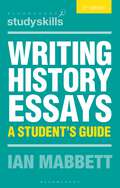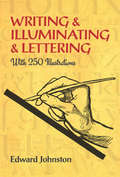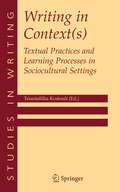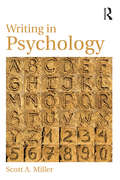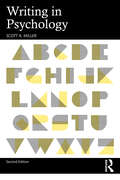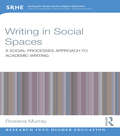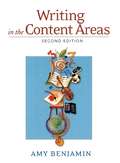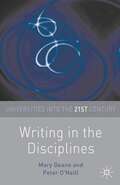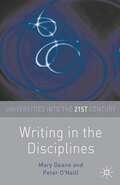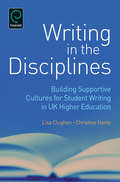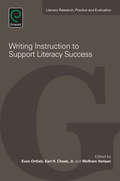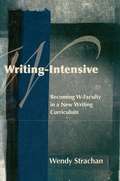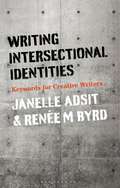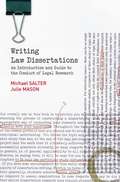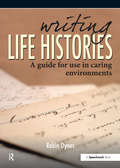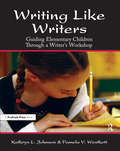- Table View
- List View
Writing History Essays (Macmillan Study Skills)
by I.W. MabbettTo write history successfully, it is essential to understand the nuts and bolts of technique as well as the underlying principles which govern the whole process. Writing History Essays takes you step by step through the process of writing an assignment, breaking it down into a series of manageable tasks, including: • selecting sources• reading critically• taking notes• planning and drafting your essay• referencing correctly and avoiding plagiarism This book also takes you beyond the essay, with practical advice on writing book reviews, reports and dissertations, as well as guidance on sitting examinations. This new edition includes reflective questions at the end of each chapter and discussion of visual and web-based sources, making it an indispensable guide for history students.
Writing & Illuminating & Lettering: With 250 Illustrations
by Edward JohnstonOne of the founders of modern calligraphy, Edward Johnston regarded lettering, writing, and illuminating as not only desirable ends in themselves but also as practical avenues to mastery of typography, decoration, and design. In this classic, profusely illustrated guide, he distilled his expertise into a series of easy-to-follow lessons that will benefit any student of calligraphy, book design, or art.Part I is devoted to writing and illuminating. Early chapters cover the fundamentals of acquiring a formal hand: choosing paper, ink, and quills; holding the pen; spacing and planning a manuscript; and more. The author then turns to the techniques of producing a manuscript book: tools and materials, methods and proportions, margins, and other methods. Part II offers a detailed discussion of lettering: the qualities of good lettering, methods of construction and arrangement, spacing, proportion, and other matters. Two appendixes cover the uses of lettering in book bindings, wall inscriptions, monograms, and title pages as well as the techniques involved in lettering on metal, wood, and stone.
Writing in Context: Textual Practices and Learning Processes in Sociocultural Settings (Studies in Writing #15)
by Triantafillia KostouliThe premise that writing is a socially-situated act of interaction between readers and writers is well established. This volume first, corroborates this premise by citing pertinent evidence, through the analysis of written texts and interactive writing contexts, and from educational settings across different cultures from which we have scant evidence. Secondly, all chapters, though addressing the social nature of writing, propose a variety of perspectives, making the volume multidisciplinary in nature. Finally, this volume accounts for the diversity of the research perspectives each chapter proposes by situating the plurality of terminological issues and methodologies into a more integrative framework. Thus a coherent overall framework is created within which different research strands (i.e., the sociocognitive, sociolinguistic research, composition work, genre analysis) and pedagogical practices developed on L1 and L2 writing can be situated and acquire meaning. This volume will be of particular interest to researchers in the areas of language and literacy education in L1 and L2, applied linguists interested in school, and academic contexts of writing, teacher educators and graduate students working in the fields of L1 and L2 writing.
Writing In-House Medical Device Software in Compliance with EU, UK, and US Regulations
by Philip S. Cosgriff Matthew J. MemmottThis book is a comprehensive guide to producing medical software for routine clinical use. It is a practical guidebook for medical professionals developing software to ensure compliance with medical device regulations for software products intended to be sold commercially, shared with healthcare colleagues in other hospitals, or simply used in-house.It compares requirements and latest regulations in different global territories, including the most recent EU regulations as well as UK and US regulations.This book is a valuable resource for practising clinical scientists producing medical software in-house, in addition to other medical staff writing small apps for clinical use, clinical scientist trainees, and software engineers considering a move into healthcare. The academic level is post-graduate, as readers will require a basic knowledge of software engineering principles and practice.Key Features: Up to date with the latest regulations in the UK, the EU, and the US Useful for those producing medical software for routine clinical use Contains best practice
Writing In-House Medical Device Software in Compliance with EU, UK, and US Regulations
by Philip S. Cosgriff Matthew J. MemmottThis book is a comprehensive guide to producing medical software for routine clinical use. It is a practical guidebook for medical professionals developing software to ensure compliance with medical device regulations for software products intended to be sold commercially, shared with healthcare colleagues in other hospitals, or simply used in-house.It compares requirements and latest regulations in different global territories, including the most recent EU regulations as well as UK and US regulations.This book is a valuable resource for practising clinical scientists producing medical software in-house, in addition to other medical staff writing small apps for clinical use, clinical scientist trainees, and software engineers considering a move into healthcare. The academic level is post-graduate, as readers will require a basic knowledge of software engineering principles and practice.Key Features: Up to date with the latest regulations in the UK, the EU, and the US Useful for those producing medical software for routine clinical use Contains best practice
Writing in Psychology
by Scott A. MillerThis book helps readers become better writers of psychology and better writers in general. After reading thousands of course papers, theses, and dissertations, Dr. Miller knows and addresses the issues that students find most challenging when writing about psychology. Written with the utmost flexibility in mind, the chapters can be read in any order. More comprehensive than similar texts, this book provides detailed coverage of how to write empirical reports, research proposals, and literature reviews, and how to read meta-analyses. Readers will also find invaluable strategies for improving one’s writing including how to adopt an engaging yet accurate style, thorough coverage of grammatical and word use rules that govern writing in general, and the APA (American Psychological Association) rules that govern the expression of that content. Readers will appreciate these helpful learning tools: Describes the most common APA style rules encountered and/or highlights references to the Manual when more detailed knowledge is required. Numerous examples from journal articles that help readers gain a clearer understanding of content they will encounter in writing psychological reports. Chapter exercises that provide an opportunity to apply the points conveyed in each chapter. Examples of the most common mistakes made by students and how to avoid them and best practices for improving one’s writing. Tables that help readers gain a clearer understanding of the new standards in the APA Publications Manual, 6th ed (Appendix A). Errors in APA Style exemplified via an improperly formatted paper and another version noting corrections pertaining to APA style and grammar, to highlight the most common pitfalls encountered by students (Appendix B). Ideal for courses on writing in psychology or as a supplement for graduate or advanced undergraduate courses in research design or research methods, this book also serves as a resource for anyone looking for guidance on how to write about psychological content.
Writing in Psychology
by Scott A. MillerThis book helps readers become better writers of psychology and better writers in general. After reading thousands of course papers, theses, and dissertations, Dr. Miller knows and addresses the issues that students find most challenging when writing about psychology. Written with the utmost flexibility in mind, the chapters can be read in any order. More comprehensive than similar texts, this book provides detailed coverage of how to write empirical reports, research proposals, and literature reviews, and how to read meta-analyses. Readers will also find invaluable strategies for improving one’s writing including how to adopt an engaging yet accurate style, thorough coverage of grammatical and word use rules that govern writing in general, and the APA (American Psychological Association) rules that govern the expression of that content. Readers will appreciate these helpful learning tools: Describes the most common APA style rules encountered and/or highlights references to the Manual when more detailed knowledge is required. Numerous examples from journal articles that help readers gain a clearer understanding of content they will encounter in writing psychological reports. Chapter exercises that provide an opportunity to apply the points conveyed in each chapter. Examples of the most common mistakes made by students and how to avoid them and best practices for improving one’s writing. Tables that help readers gain a clearer understanding of the new standards in the APA Publications Manual, 6th ed (Appendix A). Errors in APA Style exemplified via an improperly formatted paper and another version noting corrections pertaining to APA style and grammar, to highlight the most common pitfalls encountered by students (Appendix B). Ideal for courses on writing in psychology or as a supplement for graduate or advanced undergraduate courses in research design or research methods, this book also serves as a resource for anyone looking for guidance on how to write about psychological content.
Writing in Psychology
by Scott A. MillerThe second edition of Writing in Psychology by Scott A. Miller is a comprehensive guide to addressing the most challenging issues that students face while writing about psychology, including what to say and how to say it. It offers practical tools to overcome the challenges and create an engaging work. The book is a valuable resource for helping readers become better writers of psychology with the aid of various helpful learning tools, which provide detailed coverage of how to write empirical reviews, research proposals, literature reviews, term papers, and posters. It examines examples from journal articles that give readers a grasp of the content they will encounter in writing psychological reports. Furthermore, it includes exercises that provide an opportunity to apply the points conveyed in each chapter, examples of ways to avoid the most common mistakes made by students, and a guide to the best practices for improving one’s writing. Readers will also develop a thorough understanding of how to write in an engaging yet accurate style, using grammatical and word use rules that govern writing in general, and the rules of seventh edition APA (American Psychological Association) Publication Manual that determine the expression of that content. Throughout, the book emphasizes inclusion, diversity, and fair treatment of those with whom psychologists deal, in research and writing. The book will benefit anyone looking for guidance on how to write about psychological content. It is ideal for research scholars and psychology students as a primary text for writing in psychology courses and a supplement for graduate or advanced undergraduate courses in research design or research methods.
Writing in Psychology
by Scott A. MillerThe second edition of Writing in Psychology by Scott A. Miller is a comprehensive guide to addressing the most challenging issues that students face while writing about psychology, including what to say and how to say it. It offers practical tools to overcome the challenges and create an engaging work. The book is a valuable resource for helping readers become better writers of psychology with the aid of various helpful learning tools, which provide detailed coverage of how to write empirical reviews, research proposals, literature reviews, term papers, and posters. It examines examples from journal articles that give readers a grasp of the content they will encounter in writing psychological reports. Furthermore, it includes exercises that provide an opportunity to apply the points conveyed in each chapter, examples of ways to avoid the most common mistakes made by students, and a guide to the best practices for improving one’s writing. Readers will also develop a thorough understanding of how to write in an engaging yet accurate style, using grammatical and word use rules that govern writing in general, and the rules of seventh edition APA (American Psychological Association) Publication Manual that determine the expression of that content. Throughout, the book emphasizes inclusion, diversity, and fair treatment of those with whom psychologists deal, in research and writing. The book will benefit anyone looking for guidance on how to write about psychological content. It is ideal for research scholars and psychology students as a primary text for writing in psychology courses and a supplement for graduate or advanced undergraduate courses in research design or research methods.
Writing in Social Spaces: A social processes approach to academic writing (Research into Higher Education)
by Rowena MurrayWriting in Social Spaces addresses the problem of making time and space for writing in academic life and work of the professionals and practitioners who do academic writing'. Even those who want to write, who know how to write well and who have quality publications, report that they cannot find enough time for writing. Many supervisors are unsure about how to help postgraduates improve their writing for thesis and publication. Whilst the problem does presents through concerns with ‘time’, it is also partly about writing practices, academic identities and lack of motivation. This book provides a research-based, theorised approach to the skill of writing whilst retaining a link to writing practices and giving immediate yet sustainable solutions to the writing problem. It supplies new theory and practice on: socializing writing-in-progress and writing with others exploring the alternation of conscious and unconscious, internal and external processes in academic writing whilst in a social grouping Applying social processes in the writing process Using case studies and vignettes of writing in social spaces to illustrate the theory in practice, This book is a valuable resource for academics, scholars, professionals and practitioners, as well as researchers at all stages of their career, and in all disciplines.
Writing in Social Spaces: A social processes approach to academic writing (Research into Higher Education)
by Rowena MurrayWriting in Social Spaces addresses the problem of making time and space for writing in academic life and work of the professionals and practitioners who do academic writing'. Even those who want to write, who know how to write well and who have quality publications, report that they cannot find enough time for writing. Many supervisors are unsure about how to help postgraduates improve their writing for thesis and publication. Whilst the problem does presents through concerns with ‘time’, it is also partly about writing practices, academic identities and lack of motivation. This book provides a research-based, theorised approach to the skill of writing whilst retaining a link to writing practices and giving immediate yet sustainable solutions to the writing problem. It supplies new theory and practice on: socializing writing-in-progress and writing with others exploring the alternation of conscious and unconscious, internal and external processes in academic writing whilst in a social grouping Applying social processes in the writing process Using case studies and vignettes of writing in social spaces to illustrate the theory in practice, This book is a valuable resource for academics, scholars, professionals and practitioners, as well as researchers at all stages of their career, and in all disciplines.
Writing in the Content Areas
by Amy BenjaminDo you spend entirely too much time correcting your students' papers? Do your students' essays and term papers take side trips to nowhere? Is their writing riddled with mechanical errors? Do their lab reports and essays lack specificity and clarity? Writing in the Content Areas, Second Edition is for middle and high school content area teachers who assign essays, term papers, lab reports, and other writing tasks to students. This book provides strategies and tips to help teachers of social studies, science, art, etc. improve the quality of students' writing and apply national and state curriculum standards in your classroom. The strategies in this book can be integrated easily into every teacher's daily plans. They will help your students improve their abilities to - reflect before writing - organize and classify - provide detail without padding - use technical terminology correctly - avoid unnecessary words - spell correctly- take useful notes while they read and during your lectures.This book will help teachers - get what they want from a writing task - frame their assignments more precisely - correct student papers more quickly and efficientlyThe new second edition offers activities and strategies which involve technology (word processing, presentation programming, the Internet, and e-communications), differentiated instruction, and brain-based learning.
Writing in the Content Areas
by Amy BenjaminDo you spend entirely too much time correcting your students' papers? Do your students' essays and term papers take side trips to nowhere? Is their writing riddled with mechanical errors? Do their lab reports and essays lack specificity and clarity? Writing in the Content Areas, Second Edition is for middle and high school content area teachers who assign essays, term papers, lab reports, and other writing tasks to students. This book provides strategies and tips to help teachers of social studies, science, art, etc. improve the quality of students' writing and apply national and state curriculum standards in your classroom. The strategies in this book can be integrated easily into every teacher's daily plans. They will help your students improve their abilities to - reflect before writing - organize and classify - provide detail without padding - use technical terminology correctly - avoid unnecessary words - spell correctly- take useful notes while they read and during your lectures.This book will help teachers - get what they want from a writing task - frame their assignments more precisely - correct student papers more quickly and efficientlyThe new second edition offers activities and strategies which involve technology (word processing, presentation programming, the Internet, and e-communications), differentiated instruction, and brain-based learning.
Writing in the Disciplines (Universities into the 21st Century)
by Mary Deane Peter O'NeillWriting in the Disciplines' (WiD) is a growing field in which discipline-based academics, writing developers, and learning technologists collaborate to help students succeed as subject specialists. This book places WiD in its theoretical and cultural contexts and reports on initiatives taking place at a range of UK higher education institutions. Also includes surveys of current developments and scholarship in the US, Australia, Europe and elsewhere, making it of interest to both a UK and an international audience.
Writing in the Disciplines (Universities into the 21st Century)
by Mary Deane Peter O'NeillWriting in the Disciplines (WiD) is a growing field in which discipline-based academics, writing developers, and learning technologists collaborate to help students succeed as subject specialists. This book places WiD in its theoretical and cultural contexts and reports on initiatives taking place at a range of UK higher education institutions. Also includes surveys of current developments and scholarship in the US, Australia, Europe and elsewhere, making it of interest to both a UK and an international audience.
Writing in the Disciplines: Building Supportive Cultures for Student Writing in UK Higher Education (0)
by Christine Hardy Lisa ClughenWriting in the Disciplines: Building Supportive Cultures for Student Writing in UK Higher Education examines and develops the praxis of writing at university from a sociocultural perspective. Chapters focus on key issues in writing environments from school through various disciplines at university, offering insights into the impact of such environments on student-writers and on the ways in which they construct writing differently. The book draws on empirical research, practice and the existing body of knowledge to offer practical activities developed by scholars in specific disciplinary contexts that can be used effectively with student-writers in other disciplines. The purpose is to improve the student experience and engagement with their studies; to influence debates about academic writing within the academy, both globally and locally, and to assist academics to articulate writing requirements for students in ways that address issues of inclusion, retention, and widening participation. From the first chapter to the last, this perceptive compilation details and informs us about writing in the disciplines from both a student and a disciplinary perspective.
Writing Instruction to Support Literacy Success (Literacy Research, Practice and Evaluation #7)
by Evan Ortlieb Earl H. Cheek Jr. Wolfram VerlaanFor the last five years or so, there has been a universal increase in expectations for academic writing alongside high-stakes tests, as students must master writing for pragmatic purposes including argumentative papers, dialogic narratives, and even research reports. All the while, research related to how to effectively prepare these students for success has been stymied with an over emphasis on other areas of literacy. This volume will feature prominent researchers sharing their evidence-based successes partnering with teachers in K-12 classrooms. It will have 3 sub-sections according to grade level appropriate instruction: K-3, 4-8, 9-12. As a result of this design, the book will have wide readership amongst educators in the early childhood, elementary, middle, and high school years.
Writing-Intensive: Becoming W-Faculty in a New Writing Curriculum
by Wendy StrachanIn one of the few book-length studies of a major post-secondary writing-across-the-curriculum initiative from concept to implementation, Writing-Intensive traces the process of preparation for new writing requirements across the undergraduate curriculum at Simon Fraser University, a mid-sized Canadian research university. As faculty members across campus were selected to pilot writing-intensive courses, and as administrators and committees adjusted the process toward full implementation, planners grounded their pedagogy in genre theory—a new approach for many non-composition faculty. So doing, the initiative aimed to establish a coherent yet rhetorically flexible framework through which students might improve their writing in all disciplines. Wendy Strachan documents this campus cultural transformation, exploring successes and impasses with equal interest. The study identifies factors to be considered to avoid isolating the teaching of writing in writing-intensive courses; to engender a university-wide culture that naturalizes writing as a vital part of learning across all disciplines; and to keep the teaching of writing organic and reflected upon in a scholarly manner across campus. A valuable case history for scholars in writing studies, WAC/WID, and curricular change studies.
Writing Intersectional Identities: Keywords for Creative Writers
by Janelle Adsit Renée M. ByrdIs it okay to write about people of other genders, races and identities? And how do I do this responsibly?Whether you are working in fiction, poetry, drama or creative non-fiction, becoming conscious of how you represent people of different social identities is one of the most important responsibilities you have as a writer. This is the first practical guide to thinking and writing reflectively about these issues.Organised in an easy-to-use A to Z format for practicing writers, teachers and students, Writing Intersectional Identities covers such key terms as: Appropriation Authenticity Body Class Counternarrative Disability Essentialism Gender Indigenous Power Privilege RepresentationThe book is meant for writers of fiction, poetry, screenplays and creative non-fiction who are seeking to develop a writing practice that is attentive to the world. The book is supported by a companion website at www.criticalcreativewriting.com.
Writing Intersectional Identities: Keywords for Creative Writers
by Janelle Adsit Renée M. ByrdIs it okay to write about people of other genders, races and identities? And how do I do this responsibly?Whether you are working in fiction, poetry, drama or creative non-fiction, becoming conscious of how you represent people of different social identities is one of the most important responsibilities you have as a writer. This is the first practical guide to thinking and writing reflectively about these issues.Organised in an easy-to-use A to Z format for practicing writers, teachers and students, Writing Intersectional Identities covers such key terms as: Appropriation Authenticity Body Class Counternarrative Disability Essentialism Gender Indigenous Power Privilege RepresentationThe book is meant for writers of fiction, poetry, screenplays and creative non-fiction who are seeking to develop a writing practice that is attentive to the world. The book is supported by a companion website at www.criticalcreativewriting.com.
Writing Law Dissertations: An Introduction And Guide To The Conduct Of Legal Research (PDF)
by Julie Mason Michael SalterThis book covers legal dissertation level research, embracing both LL. B. and the specific demands of LL. M. dissertations. Adopting a highly practical approach, this book shows the reader how to research and write a dissertation, covering the various stages - planning, identifying key issues, utilising the appropriate research methods, time management issues, and managing one's supervision. KEY FEATURES * Shows how to avoid common stylistic and substantive pitfalls * Discusses the character and pros and cons of adopting law and policy methods for defining the issues and conducting legal research - including black letter, socio-legal, interpretive, experiential * A running example throughout the text illustrates the various points made in each section and provides continuity
Writing Life Histories: A Guide for Use in Caring Environments
by Robin Dynes"Writing Life Histories" is a practical handbook which gives clear guidance on how to put together life histories in supportive or residential settings. It provides: step-by-step guidance; ideas for different types of life histories; activities, strategies and material for prompting memories; helpful tools and writing tips; suggestions for support and forming partnerships with other local services; ideas for involving the person's family and friends; and, discussion on ethical issues to be considered. The benefits of engaging a group or an individual in life history activities include - an aid to memory; creative stimulation; a personalised identity when in a residential home; promotion of interaction and co-operation with others; and, continuity with previous life experience thus combating loss of identity as well as an excellent opportunity to pass on knowledge and experience to others. For staff knowing about past experiences will promote an understanding of behaviour, needs and outlook on life resulting in more personalised care. Staff have references for conversation with cognitive impaired individuals and knowledge about life accomplishments which promotes respect for individuals. This is an indispensible resource for anyone interested in compiling life histories including nurses, residential home staff, carers, tutors and occupational therapists, group facilitators in day centres, clubs for the elderly or learning disabilities.
Writing Life Histories: A Guide for Use in Caring Environments
by Robin Dynes"Writing Life Histories" is a practical handbook which gives clear guidance on how to put together life histories in supportive or residential settings. It provides: step-by-step guidance; ideas for different types of life histories; activities, strategies and material for prompting memories; helpful tools and writing tips; suggestions for support and forming partnerships with other local services; ideas for involving the person's family and friends; and, discussion on ethical issues to be considered. The benefits of engaging a group or an individual in life history activities include - an aid to memory; creative stimulation; a personalised identity when in a residential home; promotion of interaction and co-operation with others; and, continuity with previous life experience thus combating loss of identity as well as an excellent opportunity to pass on knowledge and experience to others. For staff knowing about past experiences will promote an understanding of behaviour, needs and outlook on life resulting in more personalised care. Staff have references for conversation with cognitive impaired individuals and knowledge about life accomplishments which promotes respect for individuals. This is an indispensible resource for anyone interested in compiling life histories including nurses, residential home staff, carers, tutors and occupational therapists, group facilitators in day centres, clubs for the elderly or learning disabilities.
Writing Like Writers: Guiding Elementary Children Through a Writer's Workshop
by Pamela V. Westkott Kathryn L. JohnsonBuild a classroom of excited, talented young writers. This wonderful teaching resource offers a complete approach to creating a classroom of enthusiastic, skillful student writers.The authors provide a comprehensive approach to teaching writing in the classroom. This book offers the strategies teachers need to teach writing skills that meet national standards and to produce excellent results from children.Topics addressed in this guidebook include:creating the writing classroom,teaching the writing process,teaching effective writing strategies,teaching elements of story structure,teaching the advanced craft of writing, andusing a writer's workshop to teach good writing. Writing is a great differentiator. During the writer's workshop, each student is engaged in meaningful ways. Pulling together more than three decades of practical experience and research on the best strategies for teaching writing, Writing Like Writers offers a friendly, easy-to-use guide for any teacher seeking to build a classroom of successful writers.Grades 2-6
Writing Like Writers: Guiding Elementary Children Through a Writer's Workshop
by Pamela V. Westkott Kathryn L. JohnsonBuild a classroom of excited, talented young writers. This wonderful teaching resource offers a complete approach to creating a classroom of enthusiastic, skillful student writers.The authors provide a comprehensive approach to teaching writing in the classroom. This book offers the strategies teachers need to teach writing skills that meet national standards and to produce excellent results from children.Topics addressed in this guidebook include:creating the writing classroom,teaching the writing process,teaching effective writing strategies,teaching elements of story structure,teaching the advanced craft of writing, andusing a writer's workshop to teach good writing. Writing is a great differentiator. During the writer's workshop, each student is engaged in meaningful ways. Pulling together more than three decades of practical experience and research on the best strategies for teaching writing, Writing Like Writers offers a friendly, easy-to-use guide for any teacher seeking to build a classroom of successful writers.Grades 2-6
